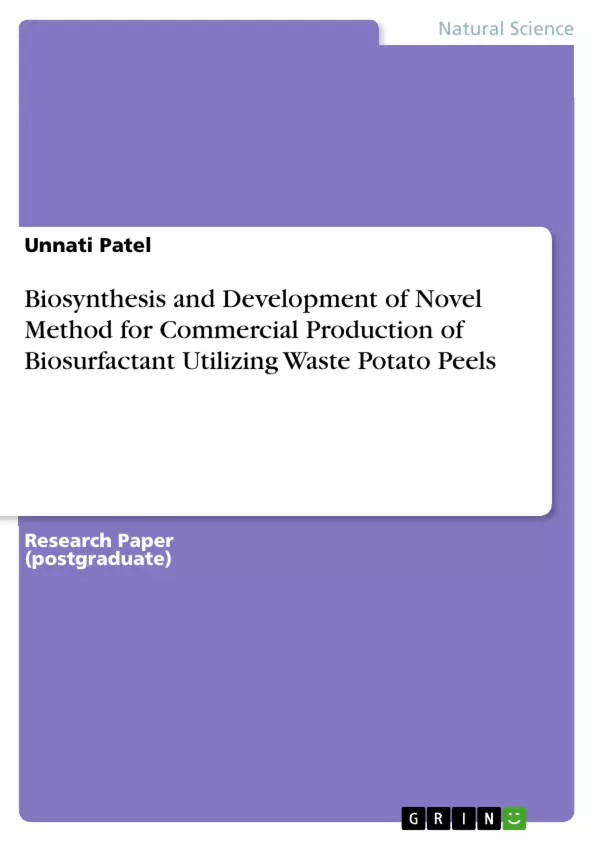Biosurfactant or microbial surfactants are surface dynamic atoms that are delivered by an assortment of microorganisms including microscopic organisms, yeast and filamentous parasite. In contrast with engineered synthetic surfactants, bio-surfactants are of interest because of their high level of activity, particular movement at outrageous temperatures, pH and saltiness, capacity to be delivered from inexhaustible feedstock and high level of biodegradability. In any case, bio surfactants have not yet been marketed widely because of low creation yields and high feedstock and cleansing expenses.
With a specific end goal to tackle this issue many investigations have been done utilizing minimal effort feedstock or farming side-effects as substrates for bio surfactant creation. The foremost extent of the test work was accordingly; to create compelling strategy, and sanitize the biosurfactant generation by waste potato peels and pulp utilizing mutated B.Subtilis DDU20161. Major upstream parameters like creation of medium, fomentation, and pH were kept up in the investigation.
Inhaltsverzeichnis (Table of Contents)
- Abstract
- Introduction
- Materials and Method
- Microorganism and culture preservation
- Experimental Conditions for the Production of Biosurfactants
- Propagation of the Inoculum
- Production of Biosurfactants in a Continuous Stirred Tank Bioreactor
- Results and Discussion
- Conclusion
- References
Zielsetzung und Themenschwerpunkte (Objectives and Key Themes)
This study focuses on the development of a cost-effective and sustainable method for commercial production of biosurfactants using waste potato peels as a substrate. The research aims to optimize biosurfactant production by Bacillus subtilis DDU20161 and investigate the properties of the produced biosurfactant, ultimately aiming for large-scale production.
- Utilization of waste potato peels as a sustainable substrate for biosurfactant production.
- Optimization of biosurfactant production using a mutated Bacillus subtilis strain.
- Characterization of the biosurfactant produced in terms of surface tension, emulsification, CMC, and FT-IR analysis.
- Evaluation of the stability of the biosurfactant under different temperature and pH conditions.
- Exploration of various extraction methods for efficient biosurfactant recovery.
Zusammenfassung der Kapitel (Chapter Summaries)
- Abstract: This chapter provides a concise overview of the research, highlighting the utilization of waste potato peels for biosurfactant production using a mutated B. Subtilis strain. It emphasizes the importance of biosurfactants as a green alternative to synthetic surfactants and their potential applications in various industries.
- Introduction: This chapter discusses the increasing demand for sustainable alternatives to synthetic surfactants and the advantages of biosurfactants. It introduces the chosen microorganism, B. Subtilis, and its potential for biosurfactant production. Furthermore, it addresses the challenges associated with commercial biosurfactant production, such as low yields and high costs, and highlights the potential of waste potato peels as a cost-effective substrate.
- Materials and Method: This chapter details the experimental methodology used for biosurfactant production. It describes the isolation, identification, and mutation of the B. Subtilis strain, the preparation of the culture medium, and the experimental conditions for biosurfactant synthesis. The chapter also explains the different methods used for biosurfactant extraction and characterization.
Schlüsselwörter (Keywords)
This research explores the production and characterization of biosurfactants using waste potato peels as a substrate. Key themes include sustainability, green chemistry, bioremediation, and the development of alternative methods for industrial-scale production of biosurfactants. The work centers around the study of microbial surfactants, B. Subtilis, and their application in various fields.
- Citar trabajo
- Unnati Patel (Autor), 2019, Biosynthesis and Development of Novel Method for Commercial Production of Biosurfactant Utilizing Waste Potato Peels, Múnich, GRIN Verlag, https://www.grin.com/document/1417662



